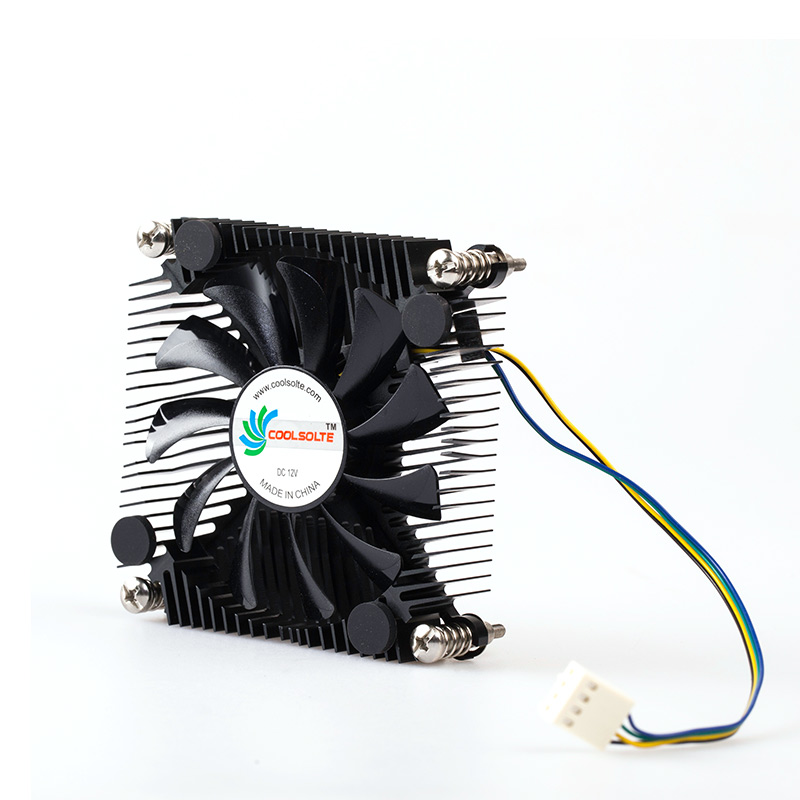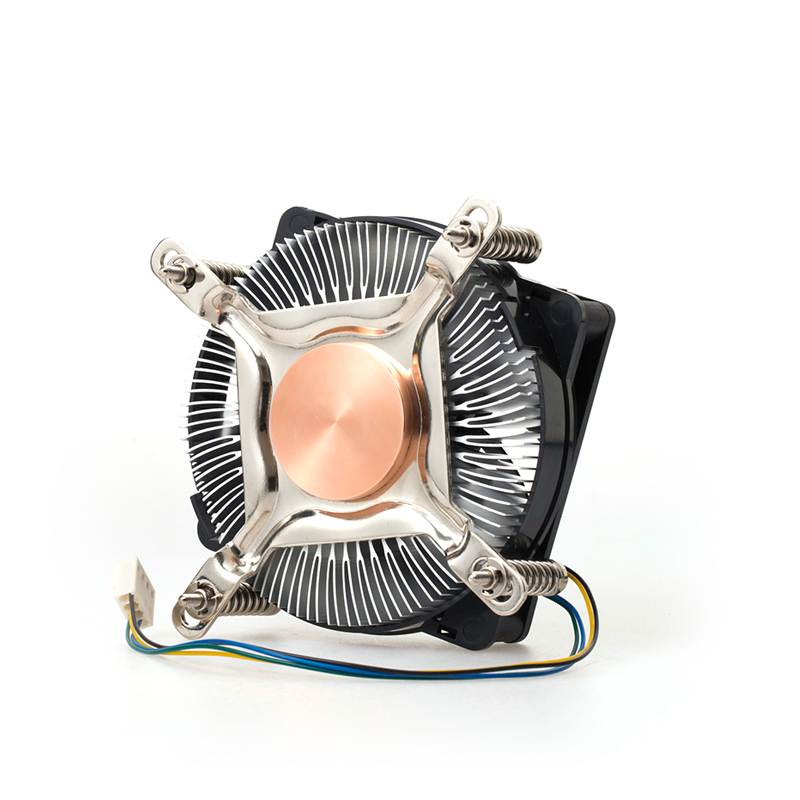

Views: 97 Author: Site Editor Publish Time: 2023-11-16 Origin: Site
In the realm of computer hardware, particularly in the efficient cooling of CPUs, the debate between traditional mounting methods and the innovative use of spring-loaded screws is a topic of interest for both users and CPU cooler manufacturers. This article delves into the nuances of these two methods, highlighting their installation, maintenance, and performance advantages.


Installation Ease: Simplifying the Process
Traditionally, CPU coolers have been mounted using various methods, each challenging. These methods, while reliable, often require a significant amount of manual adjustment and precision. The process can be time-consuming and daunting, especially for those who are not seasoned in computer hardware assembly. The risk of uneven pressure distribution is a notable concern, as it can directly impact the thermal efficiency of the cooler.
Enter the innovation of spring-loaded screws in CPU coolers. This design, increasingly adopted by CPU cooler manufacturers, simplifies the installation process significantly. The spring-loaded mechanism ensures that the screws apply a consistent and optimal amount of pressure on the CPU. This makes the installation process quicker and reduces the likelihood of installation errors. For beginners and experienced users alike, spring-loaded screws offer a hassle-free and more efficient installation experience.
With traditional CPU cooler mounting methods, maintenance can be more involved. Over time, the cooler may require readjustment to maintain optimal contact with the CPU. This is particularly important as the thermal paste ages or if the cooler shifts slightly due to movement or transport of the system. Additionally, reapplying thermal paste and ensuring even pressure during remounting can be challenging, often requiring a careful and experienced hand.
Spring-loaded screws CPU coolers, on the other hand, offer a significant advantage in terms of maintenance. The consistent pressure provided by the springs ensures that the cooler maintains optimal contact with the CPU over time, reducing the need for frequent adjustments. This stability is particularly beneficial when it comes to reapplying thermal paste. Users can be confident that remounting the cooler will provide the same pressure as the initial installation, leading to reliable thermal performance and easier maintenance.
The performance of traditional CPU cooler mounting methods can vary significantly based on the precision of the installation. More than incorrect mounting can lead to uneven cooling, resulting in hotspots on the CPU. This inconsistency can be a significant drawback for users who demand optimal system performance, especially under heavy load conditions.
Spring-loaded screws CPU coolers shine in their ability to provide consistent thermal performance. The even pressure distribution ensures uniform contact between the CPU and the cooler, which is crucial for efficient heat dissipation. This consistency is beneficial for initial installation and plays a vital role in maintaining performance over time. Additionally, the reduced risk of damage to the CPU or motherboard due to uneven pressure is a significant advantage, particularly for less experienced users or those who frequently upgrade or modify their systems.
The evolution of CPU cooler technology is heavily influenced by the innovations brought forth by CPU cooler manufacturers. Recognizing the demand for easier installation and maintenance without compromising on performance, manufacturers are increasingly incorporating spring-loaded screws into their designs. This trend is a response to consumer preferences and a reflection of the industry's commitment to advancing technology for better user experiences. As manufacturers continue to innovate, we expect to see more refined and efficient cooling solutions catering to novice and experienced users.
The preferences of users, ranging from casual computer enthusiasts to hardcore gamers and professional system builders, play a crucial role in shaping the CPU cooler market. While some users prefer the control and flexibility offered by traditional mounting methods, many are leaning toward solutions that provide ease and reliability. This shift is driving CPU cooler manufacturers to focus on designs that are not only high-performing but also user-friendly. The balance between ease of installation, maintenance, and top-tier performance is becoming a critical factor in the decision-making process for consumers.
One crucial aspect often overlooked in the discussion of CPU cooler mounting methods is the impact on noise levels. Traditional mounting methods can sometimes increase vibration, resulting in higher noise levels. On the other hand, spring-loaded screws can provide:
· A more secure and stable fit.
· Potentially reducing vibration and, consequently.
· The operational noise of the CPU cooler.
This is a significant consideration for users who prioritize a quiet computing environment.
In the era of customized PC builds, the aesthetic appeal of CPU coolers has become increasingly important. Manufacturers are now paying close attention to their coolers' design and visual appeal. The sleek and sophisticated look of a cooler with spring-loaded screws can be a deciding factor for users who value not only the performance but also the appearance of their setup.
Another challenge in CPU cooler design is ensuring compatibility with a wide range of motherboard and CPU socket types. Manufacturers must balance the need for a universal fit with the cooler's effectiveness. This is where the design of mounting mechanisms, including spring-loaded screws, plays a crucial role. A well-designed mounting system can provide versatility and reliability across different hardware configurations.
Adaptability is key in CPU cooler design, as manufacturers aim to cater to diverse system requirements and user preferences. This includes adjusting to different case sizes, airflow configurations, and cooling demands. The flexibility offered by advanced mounting systems, including those with spring-loaded screws, allows users to customize their cooling solutions to their specific needs.
The debate between liquid and traditional air cooling continues as technologies in both domains evolve. Liquid cooling systems are becoming more accessible and user-friendly, offering superior cooling capabilities, especially in high-performance setups. However, air coolers, particularly those with advanced mounting systems like spring-loaded screws, remain popular due to their simplicity and reliability.
Innovations in liquid cooling are making it a more viable option for a broader range of users. These include improvements in leak-proof designs, easier installation processes, and more efficient heat dissipation technologies. As these systems become more user-friendly and less intimidating, they will likely see increased adoption among mainstream users.
Integrating AI and intelligent technologies into CPU coolers is an emerging trend. These innovative cooling systems can dynamically adjust performance based on real-time temperature data, workload, and user preferences, optimizing cooling efficiency and energy consumption.
AI technologies also have the potential to revolutionize maintenance in CPU cooling. By predicting maintenance needs and adjusting performance accordingly, these systems can extend the cooler's life and maintain optimal performance without user intervention.
As environmental concerns become more prominent, CPU cooler manufacturers are exploring sustainable materials and practices. This includes using recycled materials, eco-friendly packaging, and manufacturing processes that minimize environmental impact.
Energy-efficient designs in CPU coolers are not just beneficial for reducing operational costs but also crucial in reducing the environmental footprint of computing systems. Efficient cooling systems require less power, contributing to the overall energy efficiency of the computer.
Efficient cooling is directly linked to reduced power consumption in computers. As cooling technologies advance, their role in promoting green computing becomes increasingly significant, focusing on developing solutions that offer optimal performance with minimal energy use.
Looking ahead, innovations in CPU cooling are expected to focus more on sustainability. This includes the development of more energy-efficient cooling solutions and the use of materials and processes that are environmentally friendly, contributing to the broader goal of sustainable computing.
The future of CPU cooling technology is dynamic and user-centric, driven by technological advancements, user feedback, and a growing emphasis on sustainability. As manufacturers continue to innovate and adapt to changing user needs and environmental considerations, we expect to see a new generation of CPU coolers that are more efficient, effective, and aligned with users' values and preferences. This evolution will play a crucial role in shaping the future of computing, making it more accessible, customizable, and environmentally responsible.